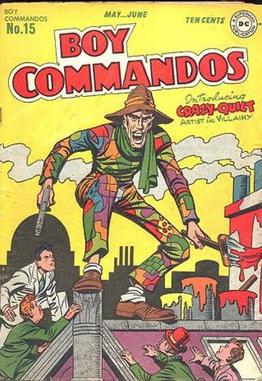Crazy Quilt
Crazy Quilt is a quilting technique and art form that involves piecing together irregular and often scrap pieces of fabric into a unique and complex design. Unlike traditional quilting, which typically involves uniform and symmetrical patterns, crazy quilting is characterized by its eclectic and improvisational approach. This method became particularly popular in the late 19th century, during the Victorian era, and has seen various revivals over the years due to its expressive freedom and the opportunity it provides to showcase needlework skills.
History[edit | edit source]
The origins of crazy quilting can be traced back to the late 1800s in the United States. It was during this time that the Japanese Pavilion at the 1876 Philadelphia Centennial Exposition introduced American audiences to the concept of asymmetrical art, influencing the aesthetic preferences of the period. Crazy quilts became a canvas for elaborate embroidery and a way to display the maker's needlework skills and artistic flair. They were often made from luxurious materials such as silk, velvet, and brocade, and embellished with intricate embroidery stitches, making them more decorative than functional.
Techniques[edit | edit source]
Crazy quilting does not follow a set pattern. Instead, it involves piecing together fabric scraps of various shapes, sizes, and textures. The seams where the pieces meet are typically covered with decorative embroidery stitches, adding to the quilt's complexity and aesthetic appeal. Popular stitches include the feather stitch, herringbone stitch, and chain stitch. Embellishments such as beads, lace, and ribbons are also commonly added, making each quilt a unique work of art.
Cultural Significance[edit | edit source]
Crazy quilts hold a special place in the history of quilting and American folk art. They are seen as a reflection of the maker's personal style and creativity, as well as a testament to the resourcefulness of women during a time when materials were often scarce. Crazy quilts also served as a means of storytelling, with each piece of fabric and every stitch potentially holding sentimental value or representing a specific event or person in the maker's life.
Modern Crazy Quilting[edit | edit source]
In contemporary times, crazy quilting continues to be a popular technique among quilters and fiber artists. Modern technology and materials have expanded the possibilities for creativity, allowing for even more elaborate and detailed works. Crazy quilting is not only a way to repurpose fabric scraps but also a form of artistic expression that bridges the gap between traditional craft and modern art.
See Also[edit | edit source]
This craft related article is a stub. You can help WikiMD by expanding it.
Search WikiMD
Ad.Tired of being Overweight? Try W8MD's physician weight loss program.
Semaglutide (Ozempic / Wegovy and Tirzepatide (Mounjaro / Zepbound) available.
Advertise on WikiMD
|
WikiMD's Wellness Encyclopedia |
| Let Food Be Thy Medicine Medicine Thy Food - Hippocrates |
Translate this page: - East Asian
中文,
日本,
한국어,
South Asian
हिन्दी,
தமிழ்,
తెలుగు,
Urdu,
ಕನ್ನಡ,
Southeast Asian
Indonesian,
Vietnamese,
Thai,
မြန်မာဘာသာ,
বাংলা
European
español,
Deutsch,
français,
Greek,
português do Brasil,
polski,
română,
русский,
Nederlands,
norsk,
svenska,
suomi,
Italian
Middle Eastern & African
عربى,
Turkish,
Persian,
Hebrew,
Afrikaans,
isiZulu,
Kiswahili,
Other
Bulgarian,
Hungarian,
Czech,
Swedish,
മലയാളം,
मराठी,
ਪੰਜਾਬੀ,
ગુજરાતી,
Portuguese,
Ukrainian
Medical Disclaimer: WikiMD is not a substitute for professional medical advice. The information on WikiMD is provided as an information resource only, may be incorrect, outdated or misleading, and is not to be used or relied on for any diagnostic or treatment purposes. Please consult your health care provider before making any healthcare decisions or for guidance about a specific medical condition. WikiMD expressly disclaims responsibility, and shall have no liability, for any damages, loss, injury, or liability whatsoever suffered as a result of your reliance on the information contained in this site. By visiting this site you agree to the foregoing terms and conditions, which may from time to time be changed or supplemented by WikiMD. If you do not agree to the foregoing terms and conditions, you should not enter or use this site. See full disclaimer.
Credits:Most images are courtesy of Wikimedia commons, and templates, categories Wikipedia, licensed under CC BY SA or similar.
Contributors: Prab R. Tumpati, MD

